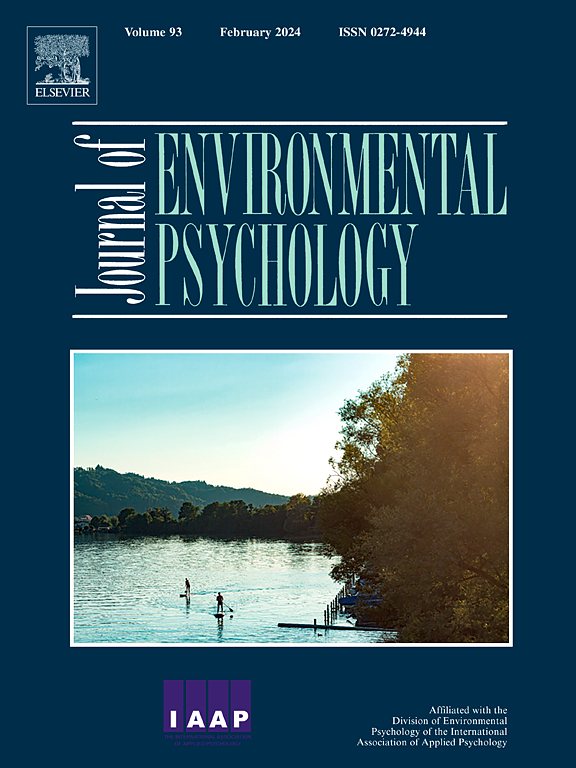Seeking external recognition or pursuing internal satisfaction: The mechanism of social comparison in social media on digital green intention
IF 7
1区 心理学
Q1 ENVIRONMENTAL STUDIES
引用次数: 0
Abstract
With the proliferation of social media, digital green behavior has increasingly become an important means of environmental communication. However, the mechanisms behind individuals' motivations to showcase green behavior on social media and their subsequent behavioral impacts have not been systematically explored. This study focuses on the formation and transformation process of digital green intention in the social media environment, developing a two-stage theoretical model and conducting three experiments. The findings are as follows (1) Upward (vs. downward): social comparison more readily stimulates externally recognition-oriented (vs. internally satisfaction-oriented) digital green intention. (2) Social norm perception significantly moderates the relationship between social comparison and digital green intention (3) Externally recognition-oriented (vs. internally satisfaction-oriented). digital green intention more effectively promotes conspicuous (vs. altruistic) prosocial behavior. (4) Green self-efficacy plays a significant mediating role in the path through which digital green intention influences altruistic prosocial behavior, but the mediating effect is not significant in the path leading to conspicuous prosocial behavior. (5) Social norm perception moderates the relationship between digital green intention and conspicuous prosocial behavior, but the moderating effect is not significant in the path affecting altruistic prosocial behavior. This study extends the theoretical boundary of digital green behavior research and provides differentiated governance insights for optimizing social media platform designs, formulating green communication strategies, and implementing environmental policies.
寻求外部认可还是追求内部满足:社交媒体中社会比较对数字绿色意愿的影响机制
随着社交媒体的普及,数字绿色行为日益成为环境传播的重要手段。然而,个人在社交媒体上展示绿色行为的动机及其随后的行为影响背后的机制尚未得到系统的探讨。本研究着眼于社交媒体环境下数字绿色意向的形成和转化过程,建立了两阶段理论模型,并进行了三次实验。研究发现:(1)向上(相对于向下):社会比较更容易激发外部认可导向(相对于内部满意导向)的数字绿色意愿。(2)社会规范知觉显著调节社会比较与数字绿色意向之间的关系(3)外部认可导向(vs.内部满意导向)。数字绿色意向更有效地促进了炫耀性(相对于利他性)亲社会行为。(4)绿色自我效能感在数字绿色意愿影响利他性亲社会行为的路径中起显著中介作用,但在导致显著性亲社会行为的路径中中介作用不显著。(5)社会规范知觉调节数字绿色意愿与显著性亲社会行为的关系,但在影响利他性亲社会行为的路径上调节作用不显著。本研究拓展了数字绿色行为研究的理论边界,为优化社交媒体平台设计、制定绿色传播策略和实施环境政策提供了差异化的治理见解。
本文章由计算机程序翻译,如有差异,请以英文原文为准。
求助全文
约1分钟内获得全文
求助全文
来源期刊

Journal of Environmental Psychology
Multiple-
CiteScore
10.60
自引率
8.70%
发文量
140
审稿时长
62 days
期刊介绍:
The Journal of Environmental Psychology is the premier journal in the field, serving individuals in a wide range of disciplines who have an interest in the scientific study of the transactions and interrelationships between people and their surroundings (including built, social, natural and virtual environments, the use and abuse of nature and natural resources, and sustainability-related behavior). The journal publishes internationally contributed empirical studies and reviews of research on these topics that advance new insights. As an important forum for the field, the journal publishes some of the most influential papers in the discipline that reflect the scientific development of environmental psychology. Contributions on theoretical, methodological, and practical aspects of all human-environment interactions are welcome, along with innovative or interdisciplinary approaches that have a psychological emphasis. Research areas include: •Psychological and behavioral aspects of people and nature •Cognitive mapping, spatial cognition and wayfinding •Ecological consequences of human actions •Theories of place, place attachment, and place identity •Environmental risks and hazards: perception, behavior, and management •Perception and evaluation of buildings and natural landscapes •Effects of physical and natural settings on human cognition and health •Theories of proenvironmental behavior, norms, attitudes, and personality •Psychology of sustainability and climate change •Psychological aspects of resource management and crises •Social use of space: crowding, privacy, territoriality, personal space •Design of, and experiences related to, the physical aspects of workplaces, schools, residences, public buildings and public space
 求助内容:
求助内容: 应助结果提醒方式:
应助结果提醒方式:


